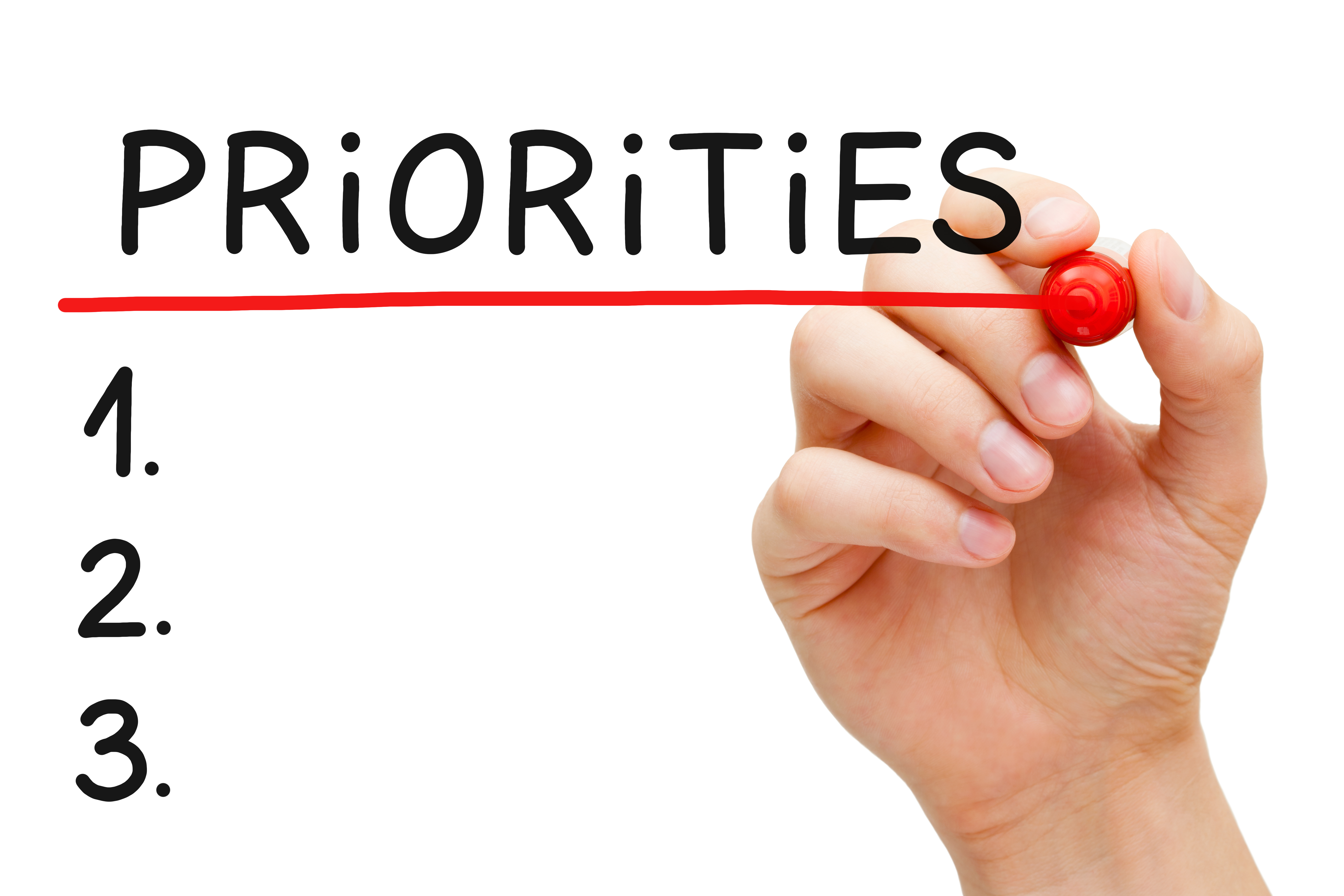
by Julie | Jun 12, 2018 | Leadership, Management
A few months ago, my husband and I had to put down our beloved Copper, a 10-year-old red fox Labrador retriever. She was diagnosed with skin cancer in September and had stopped responding to chemo. She was at the vet when I got the call that it was time for us to let her go. We agreed to wait until the end of the day so both my husband and I could say good-bye. When I arrived at the vet, my husband was already in the grieving room with Copper. When I walked into the room, Copper immediately jumped up and came running up to me. She was so happy to see me. I petted her for a while and then she sat on our laps and, well, we all know what happened from there.
Over the past few months, I have reflected back on the moment I walked into that grieving room over a hundred times. I was so distracted by how sad I was to lose her, by anger at her having cancer and by how much I really didn’t want to go through this emotional experience. But what I think about most is how much I wish I had been more present in that moment. I let all these other things distract me from being there and experiencing the joy of watching her run over and greet me when I walked into the room.
I have read a lot of books recently about the importance of setting intention. Before entering into a conversation with your spouse, your child or even a co-worker, think about the intention that you want to set. Too often we carry our emotions from one situation into the next situation. This can cause us to be distracted, bringing baggage that doesn’t belong, and ultimately we may miss an opportunity to truly connect with another person.
When we take the time to think about the energy we want to bring into a situation, we are creating the opportunity to put our best self in that situation. Being intentional about the energy we want to bring into the moment can shape the situation into something impactful for all parties involved. The situation might not be enjoyable, but we have the opportunity to be intentional about how we respond to some of life’s unpleasant times.
I wish I had put all my worries behind me when I spent those last precious moments with Copper. Not being fully in the moment didn’t make it hurt less, but it does make me sad that I didn’t set the intention to give her all of my attention just one last time.

by Julie | Apr 10, 2018 | Management
The topic of employee expectations came up recently with one of my clients. The client was talking specifically about attendance and showing up to work on time, but this argument applies to many aspects of an organization. The client’s perspective was that managers had no clear way to enforce the attendance policy, so they didn’t address the issue with employees. This thought process assumes that employees are showing up late because there is no way to enforce the policy. I believe that people want to come to work and do a good job. But if they don’t know what “a good job” looks like, they are left to set their own priorities.
One of my favorite Zig Ziglar quotes captures the idea: “You can’t hit a target you cannot see, and you cannot see a target you do not have.”
If everyone is working toward a common goal, and that goal has been communicated clearly, then each individual can understand how his behavior is contributing to that goal. But if you don’t have clear common goals, each individual will establish his own goals and corresponding behavior, which may or may not be in line with the common goal.
For example, if an accident-free workplace is a priority, what does that mean in terms of employee behavior? The management team has to establish goals for working in a safe manner, then communicate what actions need to be taken by each employee in order to achieve an accident-free workplace. Similarly, if throughput is a priority, what is the goal for throughput on the individual level, and what actions need to be taken to support that goal?
Simply establishing and articulating goals isn’t enough. The management team also has to demonstrate a commitment to the goals. I’ve seen a number of companies who say safety is a top priority, yet upper management refuses to follow the safety rules established by the safety committee. I’ve witnessed managers treating their employees disrespectfully, then being upset with the lack of teamwork within the organization.
The success of an organization lies with the management team and its commitment to developing, communicating and supporting the goals of the company. Once the goals have been established, the next step is to ensure that each individual understands how his or her behavior can impact the achievement of those goals. The last step is to provide consistent feedback on how individuals are performing against those goals.
Clearly defining the goals, outlining how individual contributions impact those goals and supporting each individual in the achievement of those goals will create a collaborative work environment where everyone wins.

by Julie | Feb 19, 2018 | Management
Why is Why Important?
Over the past few months, I have observed a trend within our society. We seem to be afraid to ask “Why” when a difficult or unusual situation presents itself. For some reason, we accept the situation, even if it doesn’t seem to make sense and then start making assumptions as to the reason. I’ve seen this with customers, employees and even friends and family.
We all know what happens when we start making assumptions, and it is true (to a certain extent). The “Why” is important as it impacts how we respond to the situation.
Here are a few examples of what happens when we don’t stop and ask Why:
- A manager noticed that an employee had been really distant recently but she didn’t really worry as she assumed this was a due to the Lyme disease that the employee was recently diagnosed with. The reality was that the employee was very upset with her manager due to a perceived lack of concern resulting in a very unhappy, unproductive employee who was spreading discontent throughout the team. If the manager had spoken with the employee when she sensed the distance, perhaps this discontent could have been resolved before it impacted the productivity of the entire office.
- The largest customer of a small manufacturing company calls and asks to have a meeting. Instead of asking why the customer wanted the meeting, the sales person sets it up for a week later and immediately begins to stress over the reason for the meeting. Was the customer going to fire the company due to the number of late deliveries? Did the customer want a price reduction due to some recent production issues? Was the sales person going to lose her job if she lost this account? By the time the day of the meeting arrived, the sales person wasn’t able to eat or sleep. However, in the end, the customer expressed their desire to continue working with the company but wanted a commitment from the company to improve on-time delivery.
It is my belief that if your intentions are pure, you have the right to ask Why when a situation presents itself that seems to be out of the norm. The question must come from a place of concern and not accusation; a place of learning, not an effort to gain the upper hand.
I’m not saying these conversations are always easy. There may be things that are painful to share or difficult to hear. It may require you to shelve your ego and put yourself in the position of the person sharing the information. What is this person trying to tell me? Am I really focusing on what he is saying or am I preparing to respond to this perceived attack? If you don’t take the time to hear what is being said and listen with empathy, you could cause more harm than good. But, if you really listen, you have the opportunity to create a stronger relationship.
In our current climate of heated debates, 10-second sound bites and need for frenzied activity, we are missing an opportunity to connect with each other. If we view these situations as an opportunity to create deeper relationships, everyone wins.

by Julie | Jan 4, 2017 | Management
Over the past year, I’ve worked with many of you on ways to attract, train and retain your workforce. During this journey, I’ve listened to you and your challenges and what I’ve found is that some of your pain could be alleviated by instituting better processes.
So, as I considered how best to provide value to you and your businesses, I thought I’d change the topic and focus on process control tools that can help streamline your processes to enhance productivity and improve profitability.
As we move into 2017, look for a new topic and new format.
I look forward to our continued dialogue in the new year!
Best Wishes!
Julie

by Julie | Jan 4, 2017 | Employee Training, Management, Onboarding
UNDERSTANDING OUR ROLE IN ACHIEVING OUR GOALS
As 2016 comes to a close, it is time to set 2017 goals. Do you have in mind what you would like to achieve from a business perspective? Personally? In your relationships? Have you thought about how you are going to achieve your goals?
At a recent Vistage meeting, our chair asked each member of the group what our goals were for the upcoming year. And then he asked us to write down what we needed from the group in order to achieve those goals. But, then he shifted the perspective and asked what we were willing to give to the group in order to help achieve our goals.
I’ll be honest, this exercise made me uncomfortable. It was easy for me to give specifics about what they could do to help me succeed in 2017. But, as I shared with the group, the chair challenged me to answer what I would do to ensure the group could help me. After some gentle prodding, I had to admit that I would open myself up to their feedback and suggestions, even if it pushed me outside of my comfort zone.
As I reflected on this exercise, I started to realize the power in this shift in thought. It moves the conversation from ME (my goals) and YOU (what you are going to do to support me) to how WE can collectively be better.
As you set the goals for your business in 2017, have you thought about what you need from your organization in order to achieve those goals? Have you talked with your employees about their goals and what they need from you in order to achieve their goals? And then, have you asked what all of you are willing to give back to the organization in order to achieve those goals?

by Julie | Dec 2, 2016 | Efficiency, Management
LOOKING BEYOND THE MONEY
I think we can agree that most people work to make money. Of course, there are a few rare people who work because they enjoy it, but, most of them also use that money to further their personal interests.
But, beyond money what else motivates your employees? In his article, “The Ten Ironies of Motivation,” Bob Nelson stated “more than anything else, employees want to be valued for a job well done by those they hold in high esteem.”
The sad reality is that very few people work for good managers who understand the importance of providing feedback and recognition. We all have our war stories of a terrible manager we worked for, but, what about a good manager? What made her so good?
I’m confident that the answer to that question was that he truly cared about his employees and took the time to hear their concerns and give feedback on a consistent basis.
So, as 2016 comes to a close, think about ways you can provide more recognition and appreciation for your employees. It doesn’t have to cost a lot of money, in fact, I’ve put together a few ideas that don’t cost much at all:
- Write a note to one employee each week thanking them for their hard work
- Feature an employee in the company newsletter or meetings
- Ask the company president to reach out to an employee thanking him for a job well done
- Give out gift cards to employees who have gone above and beyond, or maybe “just because”
- Read positive letters from customers or clients in your staff meeting
- Allow employees to nominate each other for recognition
With Thanksgiving behind us and Christmas looming right around the corner, now is a perfect time to show appreciation for your employees.
About Julie Markee: Julie Markee is a highly conscientious, detail-oriented consultant working directly with manufacturing companies as a part-time Process Efficiency engineer or a full-time Interim Operations Manager. She utilizes tools from Lean Manufacturing and 6 Sigma, along with her extensive process experience to reduce complex challenges into manageable steps resulting in stream-lined processes, enhanced employee involvement and increased profitability. Learn more at www.keyprocessinnovations.com.

by Julie | Nov 17, 2016 | Management, Onboarding
Are you asking the right questions to determine fit and competency?
Have you ever walked out of a job interview and wondered what the point of some of the questions were? During one interview, I was asked what book I was reading. I thought to myself which answer would be better: “A Brief History of Time” by Stephen Hawking or “50 Shades of Gray” by E.L. James? Will my answer impact whether I get the job or not?
When I think about silly interview questions, I am reminded of The Internship starring Vince Vaughn and Owen Wilson. So, I thought I’d include that clip. As you watch this, think about the questions that you are asking your candidates. Are the questions centered around determining whether the candidate has the skills necessary to perform the job? Will you learn if they will fit into the company culture? Can you ascertain if the position is one that the candidate will find fulfilling?
The Internship: The Big Interview
|
|
Hiring new employees can be challenging. You want to find someone who will work well with the existing team, bring new ideas and also thrive in company culture.
So, spend time thinking about the right questions that capture how the candidate approaches difficult situations, how he has solved problems similar to what he will face in your company and what values she finds important in the work place.
If you spend that time ahead of the interview, the odds of choosing the right candidate are greater than the odds of your miniature self escaping from a blender.

by Julie | Nov 10, 2016 | Management
With the election season over (finally), I was thinking about how we pick our elected officials. Do we pick them because they are like us? Do we pick them because we respect them? Do we pick them because they are qualified to do the job? Or do we pick them because we don’t like any of the other options?
From that, I started to think about how we choose our employees. Do we pick employees that have similar interests? Do we pick employees based on their personality? Or do we pick employees because they are qualified to do the job?
Studies show that we are drawn to people who are like us and this is especially true during the hiring process. But, the reality is, you don’t want a company full of people who think the same way. This may minimize conflict but it also limits exposure to other ideas or viewpoints. You want a workforce that brings different thoughts and ideas along with the desired skill set to be a valuable team member. Terry Tigner, Managing Partner at Next Level commented that the purpose of diversity is to bring a new perspective into the workplace and if you aren’t taking advantage of that perspective, then you are missing a key advantage.
So, as you look for new employees to bring into your organization, ask yourself what skill set/personality/perspective could augment what you already have in place? Have you created a culture that is willing to accept different perspectives and viewpoints? Are you comfortable with people who have different personalities that may challenge your current workforce but could help move your organization forward?
Being aware of these issues as you move through the hiring process will aid your organization in building the optimal team to allow your business thrive.

by Julie | Nov 8, 2016 | Interim Management, Management
HINT: IT IS A 2-WAY STREET
Social media is very much a part of our society. We use this platform to connect with our friends, share our viewpoints and expand our professional connections. But, how is social media impacting the work place? I have heard of an increasing number of employers reviewing social media profiles of perspective employees during the hiring process. But, what exactly does that tell an employer?
Research shows that LinkedIn is the most used social media site when it comes to professional networking while most people have a profile on Facebook or Twitter for their personal life. Both employers and employees see a distinction between professional and personal media sites.
One of the questions that arise is whether a perspective employee’s profile on a personal social media site can be used when making a hiring decision. Perspective candidates feel their personal social media site should not be review during the hiring process while some employers feel this can provide valuable insight into the candidate.
Here are some tips to consider when evaluating your use of social media during your hiring process:
- How does your company’s social media presence appear to prospective candidates? Is the message clear and in line with the company culture? Or is there a disconnect between who you are and who you portray on social media? Attracting strong candidates is augmented by a well-rounded social media presence.
- Using social media sites can help attract both active and passive candidates. A well-crafted job description on your social media pages may spur interest from highly qualified candidates, even if they are not currently searching for a job.
- Be mindful of the decision to use personal social media sites to make hiring decisions. This could potentially expose your company to discrimination charges. If you decide not to hire a candidate based on information gathered from these sites, make sure to document why the decision was made.
- Social media is not a substitute for a robust hiring process. In the end, you need to have a methodology that will help you hire the best employees that will mesh with the company culture.










